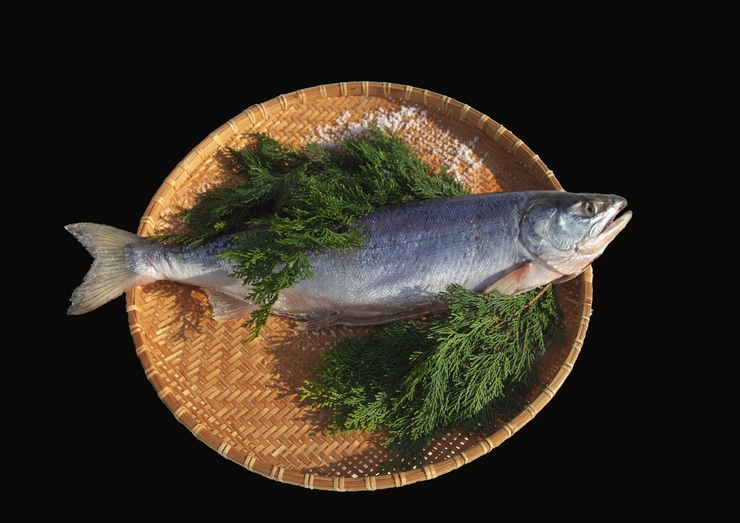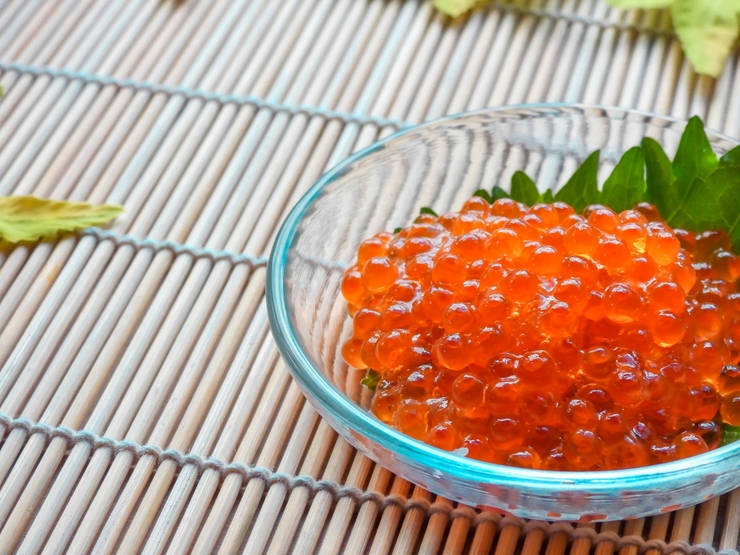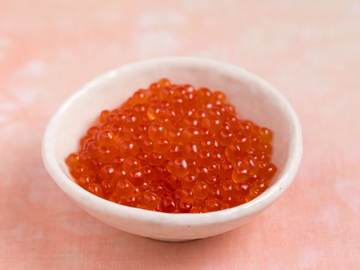Salted foods

History and Culture
Salted products are preservative foodstuffs that are prepared by dehydrating fish or other fishery product using salt or brine to improve shelf life. Addition of salt also promotes moderate aging, thereby improving the quality of flavor and texture.
It has been suggested that human use of salt dates back to before the dawn of history. In Japan, salt production dates back to the Late Jomon period to the first half of the Final Jomon period. It is believed that people in Jomon had practiced salt production with pottery, and it has been suggested that salt production occurred in different regions in the Yayoi period. With the spread of salt production, techniques of preserving food with salt also spread all over Japan. From late 7th century, people started paying taxes to the Emperor in the form of salted salmon, and varieties including the following seemed to have been used: chum salmon, sockeye salmon, and silver salmon. Sujiko (salted salmon roe sac) has been highly prized since the Heian period, and shiokazunoko (salted herring roe) has been highly prized since the Muromachi period. The production method of ikura (salted salmon roe) in brine was introduced from Russia at the end of the Meiji Period.
In the Meiji period and later, along with the development of salt production technology and salting technology, mass production of salted fishery products began, which led to an increase in variation of fermented foodstuffs using fishery products.
Fishery products that can be used for salted food include salmon, trout, mackerel, cod, pacific saury, salmon roe, and trout roe. Various forms of fish are used including semi-dressed (gills and guts removed), dressed (head and guts removed), butterflied (along the back or belly), fillets, and steaks.
Salted fish has long been served in Japanese-style meals, as dishes accompanying rice, or as delicacies.

Characteristics and Types
Characteristics of representative salted products are outlined below.
[Salted fish products]
Salted fish products are products prepared by preserving various kinds of fish with salt such as salmon, trout, cod, Alaska pollock, mackerel, Pacific saury.
For instance, salted salmon can be classified into shiobiki salmon (higher salt content) and aramaki salmon (lower salt content).
Shiobiki salmon has a longer salt-curing period, for several days to 1-2 weeks. On the other hand, aramaki salmon has a shorter curing period, for a day or two after catch, resulting in a relatively lower salt content.

[Salted fish roe products]
Salted fish roe products include salted ovary of salmon or trout (sujiko), salmon and trout roe in brine (shio-ikura), and other products prepared from roe of Alaska pollock (shio-tarako) and herring roe (shio-kazunoko).
The following are some of products developed using the fish roe products: karashi-mentaiko (salted Alaska pollock roe in liquid seasoning), seasoned kazunoko (seasoned with soy sauce and mirin), and ikura in soy sauce (salmon roe in soy sauce).
[Salted fishery products (excerpt)]
The following are some of the salted fishery products.
| Salted fish product | Shiobiki salmon |
| Aramaki salmon | |
| Salted trout | |
| Salted mackerel | |
| Salted cod | |
| Sardine | |
| Hokke (Okhotsk atka mackerel) | |
| Salted fish roe product | Sujiko |
| Shio-ikura | |
| Shio-tarako | |
| Karashi-mentaiko | |
| Seasoned kazunoko | |
| Other | e.g., salted jellyfish |
Production Methods
Production methods are roughly classified into two types: furishio-zuke (salt sprinkling) method and tatejio-zuke (immersed in brine).
[Furishio-zuke]
Salt is sprinkled directly over fish or fish roe. This method has a high dehydration effect because the surface of the fish (or roe) is constantly covered with saturated salt solution.
Due to the high penetration rate of salt into fish (or roe), deterioration of quality is unlikely to occur in the early phase of preservation; however, salt tends to penetrate unevenly into fish (or roe), and some areas come in contact with air, which promotes oxidation of lipids.
[Tatejio-zuke]
Fish or fish roe is salted by immersing in brine. Salt penetrates evenly into fish (or roe), and it does not come in contact with air, preventing lipids from being oxidized.
The method requires containers for salting, and processes to maintain the salt concentration of the brine, such as stirring and addition of salt.
There is a modified version of tatejio-zuke method, in which fish (or roe) is placed in a water-tight container, and layers of fish (or roe) are stack on top of the layer while sprinkling salt. Salt will dissolve in water that is released from the fish (or roe), so that fish (or roe) is salted in saturated salt solution.
In general, the furishio-zuke method is used for relatively large-size fish, such as salmon, trout, and cod. On the other hand, the tatejio-zuke method is used for salting small fish and fish roe, or when production of low sodium products is intended.
Relationship with Regions
Salting fish is the primary process after it is caught, and therefore fish should be processed in the vicinity of the fishing grounds. It is reasonable that Hokkaido has a high production volume of salted fishery products, and the food culture has developed in areas around fishing ports. There are a variety of salted fishery products produced by traditional techniques making use of the characteristics of seafood landed at each local fishing port. Some products are developed by using local specialty seasonings of the region instead of salt.
References
Masakatsu Sakamoto, Akihide Takiguchi, Kenichi Kawasaki, and Takao Kurokawa, edited by the Japanese Society of Traditional Food, "Nihon no Dento Shokuhin Jiten" [Encyclopedia of Traditional Japanese Food], Asakura Publishing Co., Ltd., p.353-369
Ayako Ehara, Naoko Ishihara, and Shoko Higashiyotsuyanagi, "Nihon Shokumotsushi" [The History of Japanese Foods], Yoshikawa Kobunkan, 2009, p.41

